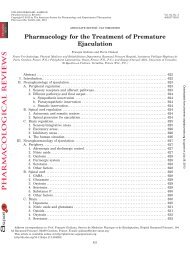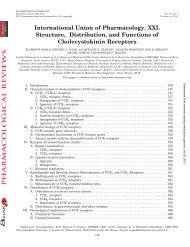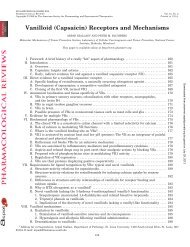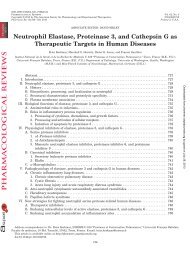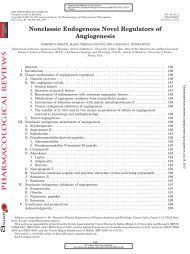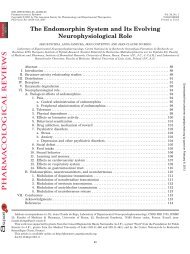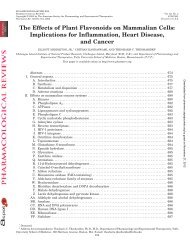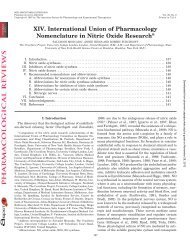Opioids, Reward and Addiction: An Encounter of Biology ...
Opioids, Reward and Addiction: An Encounter of Biology ...
Opioids, Reward and Addiction: An Encounter of Biology ...
You also want an ePaper? Increase the reach of your titles
YUMPU automatically turns print PDFs into web optimized ePapers that Google loves.
-, <strong>and</strong> -opioid receptors are involved in this facilitation<br />
(Carr <strong>and</strong> Papadouka, 1994; Carr, 1996).<br />
Strains <strong>of</strong> rats, selectively bred for high versus low<br />
rate <strong>of</strong> lateral hypothalamic ICSS were analyzed for<br />
their density <strong>of</strong> -opioid receptors in discrete brain areas<br />
using the lig<strong>and</strong> [ 3 H]DAMGO <strong>and</strong> in vitro autoradiography.<br />
The high-rate animals showed a higher <strong>and</strong> lower<br />
density <strong>of</strong> -opioid receptors in the ventral hippocampus<br />
<strong>and</strong> NAC, respectively, as compared to the low-rate animals<br />
(Gross-Isser<strong>of</strong>f et al., 1992). In addition, there is<br />
some evidence that endogenous opioids are released during<br />
self-stimulation <strong>of</strong> the VTA, as measured by the in<br />
vivo receptor occupancy procedure (Stein, 1993).<br />
In conclusion, there seems to be evidence that endogenous<br />
opioid systems are involved in ICSS. The data<br />
collected so far point to a modulatory role rather than<br />
that reward from ICSS is mediated by endogenous opioids.<br />
More studies are needed, in particular after chronic<br />
blockade <strong>of</strong> endogenous opioids, to delineate more precisely<br />
the significance <strong>of</strong> endogenous opioids for ICSS.<br />
V. Conditioned Place Preference<br />
A. Opioid Place Preference<br />
Beach (1957) was the first to report that morphine<br />
elicits conditioned place preference. In that study it was<br />
shown that in rats made physically dependent upon<br />
morphine, administration <strong>of</strong> morphine during extensive<br />
training (12–22 days <strong>of</strong> conditioning sessions, using<br />
training doses <strong>of</strong> 5–20 mg/kg morphine, injected either<br />
s.c. or i.p.) resulted in preferences for the previously<br />
nonpreferred side <strong>of</strong> a test box. During preference testing,<br />
morphine was still administered to the animals.<br />
Interestingly, a place preference was observed both<br />
when, according to the conditioning schedule, the animals<br />
were expecting an injection with morphine in the<br />
conditioned compartment (“needing morphine”) or when<br />
they had been injected with morphine 10 min to 4 h<br />
before the test session (“sated for morphine”). These<br />
results suggested that both relief from morphine withdrawal<br />
<strong>and</strong> morphine’s positive affective properties<br />
could contribute to the establishment <strong>of</strong> conditioned<br />
place preference. The place preference induced by morphine<br />
withdrawal relief appeared to persist for 3 weeks.<br />
These findings were replicated in a later study investigating<br />
the involvement <strong>of</strong> monoamines in withdrawal<br />
relief-induced conditioned place preference (Schwartz<br />
<strong>and</strong> Marchok, 1974). In the late 1970s, morphineinduced<br />
conditioned place preference was first reported<br />
in animals not previously made physically dependent on<br />
morphine (Rossi <strong>and</strong> Reid, 1976; Katz <strong>and</strong> Gormezano,<br />
1979). It was observed that when rats were conditioned<br />
at times when morphine (10 mg/kg s.c.) was expected to<br />
facilitate ICSS (1–4.5 h, but not 7 h postinjection), conditioned<br />
place preference was induced (Rossi <strong>and</strong> Reid,<br />
1976). <strong>An</strong>other study showed that as few as three conditioning<br />
sessions with morphine or an enkephalin an-<br />
OPIOIDS, REWARD AND ADDICTION 365<br />
alog, administered i.c.v., were sufficient to produce place<br />
preference (Katz <strong>and</strong> Gormezano, 1979).<br />
Using morphine <strong>and</strong> naloxone as conditioning drugs,<br />
Mucha <strong>and</strong> colleagues (Mucha et al., 1982; Mucha <strong>and</strong><br />
Iversen, 1984; Mucha <strong>and</strong> Herz, 1986) have systematically<br />
investigated several methodological variables that<br />
can influence opioid-induced place-conditioning, e.g.,<br />
dose <strong>of</strong> drug, route <strong>of</strong> administration, trial duration,<br />
number <strong>of</strong> conditioning trials, <strong>and</strong> stereospecificity <strong>of</strong><br />
the opioids. Using four conditioning trials <strong>and</strong> i.v. administration<br />
<strong>of</strong> morphine, significant place preference<br />
was found with doses ranging from 0.08 to 10 mg/kg.<br />
Trial duration <strong>of</strong> 10 to 90 min induced similar levels <strong>of</strong><br />
place preference. It appeared that one conditioning trial<br />
with 4 mg/kg morphine was sufficient to induce place<br />
preference. When morphine was administered s.c., place<br />
preference was found with 0.2 to 5 mg/kg, whereas 0.04<br />
mg/kg was ineffective. Naloxone induced place aversion,<br />
in doses ranging from 0.02 to 2 mg/kg, <strong>and</strong> 0.1 to 45<br />
mg/kg, when administered s.c. or i.p., respectively. Upon<br />
s.c. administration, three trials with morphine (1 mg/kg)<br />
or naloxone (0.5 mg/kg) were necessary to induce a significant<br />
place preference or aversion, respectively<br />
(Mucha et al., 1982; Mucha <strong>and</strong> Iversen, 1984). The<br />
development <strong>of</strong> place preference induced by morphine<br />
(0.5–2 mg/kg i.v.) was inhibited by naloxone (2 mg/kg<br />
i.p.) (Mucha et al., 1982). Stereospecificity <strong>of</strong> opioidinduced<br />
place-conditioning was demonstrated using<br />
levorphanol, which, in contrast to its inactive stereoisomer<br />
dextrorphan, induced place preference (Mucha et<br />
al., 1982; Mucha <strong>and</strong> Herz, 1986). In addition, although<br />
conditioning with ()-morphine <strong>and</strong> ()-naloxone<br />
caused place preference <strong>and</strong> aversion, respectively,<br />
()-morphine <strong>and</strong> ()-naloxone were ineffective (Mucha<br />
et al., 1982).<br />
In a follow-up study, the influence <strong>of</strong> environmental<br />
novelty <strong>and</strong> interoceptive states on morphine-induced<br />
place preference was investigated (Mucha <strong>and</strong> Iversen,<br />
1984). It appeared that animals conditioned with morphine<br />
(4 trials, 1 mg/kg s.c.) <strong>and</strong> tested after injection <strong>of</strong><br />
saline or morphine (1 mg/kg s.c.) displayed nearly identical<br />
levels <strong>of</strong> place preference. This seems to rule out<br />
any effects <strong>of</strong> state-dependent learning on the expression<br />
<strong>of</strong> morphine-induced place preference. Morphineinduced<br />
place-conditioning was also performed in a<br />
three-compartment apparatus, with one compartment<br />
being completely novel to the animals on the test day.<br />
Here, a clear preference for the morphine-paired side,<br />
over both the novel <strong>and</strong> the familiar saline-paired part <strong>of</strong><br />
the apparatus, was observed. In this experiment, the<br />
animals spent more time (albeit not statistically significant)<br />
in the novel compartment, as compared to the<br />
saline-paired environment. In a subsequent experiment,<br />
rats were placed four times in one side <strong>of</strong> the twocompartment<br />
apparatus without any injections, <strong>and</strong> no<br />
preference for the novel or familiar side was found. However,<br />
when conditioning was performed with morphine,



